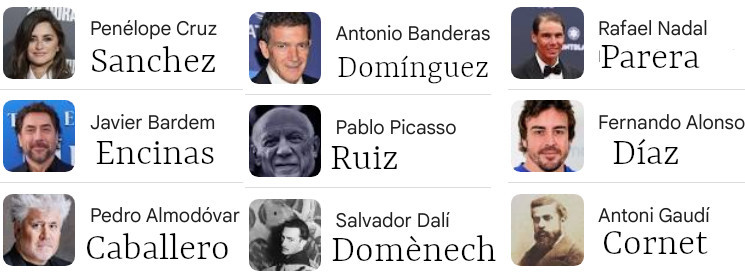
Understanding Spanish Surnames

Understanding Spanish Surnames 
Spanish surnames are rich in history and tradition, often reflecting a person’s ancestry, geography, or even profession. Most Spanish-speaking people use two surnames, which can sometimes be confusing to those unfamiliar with the custom.
Structure of Spanish Surnames 
In Spain, a person typically has two surnames: the first from their father (apellido paterno) and the second from their mother (apellido materno). For example, if Juan Martínez López and María García Sánchez have a child, the child’s full name might be Carlos Martínez García.
This tradition helps preserve both maternal and paternal family names across generations. 
Common Spanish Surnames
- García – One of the most common surnames in Spain and Latin America.
- Rodríguez – A patronymic surname meaning “son of Rodrigo.”
- López – Derived from “Lope,” meaning wolf.

- Hernández – Means “son of Hernando.”
- Martínez – Means “son of Martín.”
Marriage and Name Changes 
Unlike in some countries, women in Spain do not typically change their surnames after marriage. They retain their full birth name, and children take the first surname of each parent by default, though there is flexibility in the order since a 1999 law change.
Legal and Cultural Aspects 
Surnames in Spain are legally recorded and regulated. The civil registry ensures proper documentation of both surnames. In recent years, parents can choose the order of the surnames when registering their child’s name.
This two-surname system is a meaningful part of Spanish identity and culture, helping preserve family heritage through generations. 
Top 10 Most Common Surnames in Spain 
- García
- Rodríguez
- González
- Fernández
- López
- Martínez
- Sánchez
- Pérez
- Gómez
- Martín
Fun Facts About Spanish Surnames 
- Some surnames have a bad meaning such as ladrón (thief) or strange like pieldelobo (wolfskin)

- The most common surname in Spain is García – 1,378,000 people (3.48% of the population)
- The first letter of Spanish names and surnames have capital letters.
- In case of illegitimacy – when the child's father either is unknown or refuses to recognize his child legally – the child bears both of the mother's surnames, which may be interchanged.
- Anonymous abandoned children were a problem for civil registrars to name. Some such children were named after the town where they were found (toponymic surname). Because most were reared in church orphanages, some were also given the surnames Iglesia or Iglesias (church[es]) and Cruz (cross). Blanco (with the meaning "blank", rather than "white") was another option. A toponymic first surname might have been followed by Iglesia(s) or Cruz as a second surname.
Spanish Surname Vocabulary 
- Apellido – Surname Last name
- Nombre – First name Given name
- Nombre completo – Full name
- Apellido paterno – Father’s surname
- Apellido materno – Mother’s surname
- Segundo apellido – Second surname
- Nombre de soltera – Maiden name
- Apellidos compuestos – Compound surnames
- Registro civil – Civil registry
- Herencia familiar – Family heritage
1,066 views of this article.
Last Modified on April 22nd, 2025
Created on April 22nd, 2025
2,543,092 Total Views
This article is part of the following categories. Click on the links to see a list of similar articles:
Go to homepage
Below is a list of the most highly rated places to visit in Spain
Click on the links to see the most popular activities that you can do in these places:
Note that the booking system uses a Spanish system and there is no involvement of any American company and no US tariffs.
